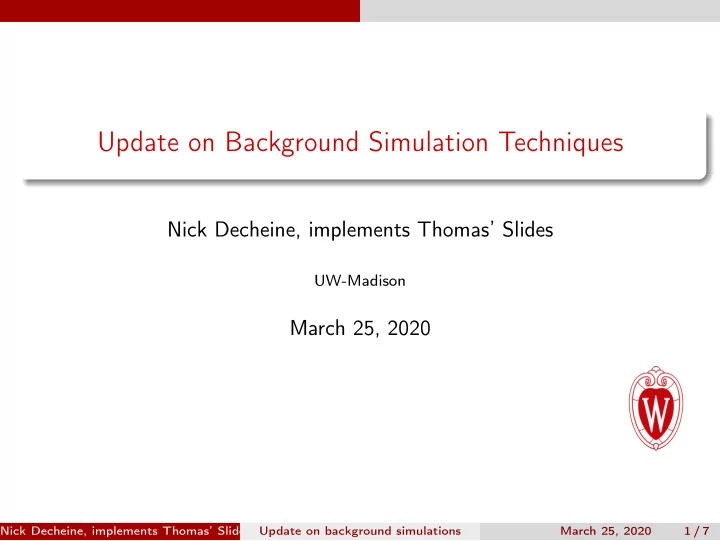

Update on Background Simulation Techniques Nick Decheine, implements Thomas’ Slides UW-Madison March 25, 2020 Nick Decheine, implements Thomas’ Slides (UW-Madison) Update on background simulations March 25, 2020 1 / 7
Outline Results 1 More realistic reactogenic background simulation 2 Improve Shielding Geometry 3 Veto techniques 4 Summary 5 Nick Decheine, implements Thomas’ Slides (UW-Madison) Update on background simulations March 25, 2020 2 / 7
Results Simulation Results Simulation results Veto results Nick Decheine, implements Thomas’ Slides (UW-Madison) Update on background simulations March 25, 2020 3 / 7
More realistic reactogenic background simulation Reactogenic Neutron Simulation The reactogenic neutron simulation is though to be unrealistic and pessimistic. Uses the energy spectrum of the neutrons leaking from the ILL H13 beamline, however: H7 site not taken into account, so the neutron energy spectrum should be softer Neutrons generated close to the shielded detector without any wall → higher neutron flux than expected Note: neutrons leaving end of H7 line have a max energy of 6 MeV. Nick Decheine, implements Thomas’ Slides (UW-Madison) Update on background simulations March 25, 2020 4 / 7
Improve Shielding Geometry Shielding Improvements Split the lead shielding into 2 layers to interpose veto Decrease thickness Use polyethylene rings in between cryostat screen panels to fill in gaps Nick Decheine, implements Thomas’ Slides (UW-Madison) Update on background simulations March 25, 2020 5 / 7
Veto techniques Full coverage muon veto Hole at the top of the cryostat outer shielding - guiding primary neutrons (red). Large contribution of muon "dying", causing neutron spallation in shielding. So decrease thickness of lead shielding. Remain 6 DRU rate with perfect veto is mainly due to primary neutrons. With top veto, muon induced background represents only 1/3 of the cosmogenic nuclear background. Nick Decheine, implements Thomas’ Slides (UW-Madison) Update on background simulations March 25, 2020 6 / 7
Summary Background Improvement Techniques Implement more realistic reactogenic simulation Design a muon-veto with full coverage Separate lead shielding into two layers Decrease lead shielding thickness Use polyethylene rings between cryostat screens to fill gaps Nick Decheine, implements Thomas’ Slides (UW-Madison) Update on background simulations March 25, 2020 7 / 7
Recommend
More recommend